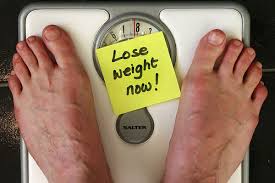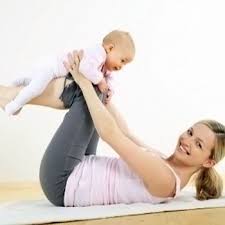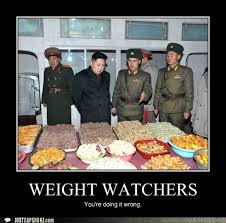People can lose weight for many reasons, perhaps intentionally through exercise training for a sports event, for health reasons, just to look better, or unintentionally as may occur because of an underlying disease. Weight loss refers to the loss of body fat (adipose tissue), fluid and/or lean mass. Lean mass are parts of your body without fat, such as bone mineral deposits, tendons, connective tissue and muscle.

Why to loose weight?
We all intentionally lose weight to:
Become fitter
Become healthier
To look better
To be eligible for a competition - such as a boxer who needs to lose a few pounds to be able to stay a middle weight, for example, or a racehorse jockey.

To improve their job prospects - in some professions there is a limit on how much you can weigh
Overweight or obese people may lose weight for therapeutic reasons. By losing weight they reduce their risk of developing diabetes, hypertension (high blood pressure), osteoarthritis, some cancers, and heart disease.

How Much Should I Weigh?
To determine how much you should weigh (your ideal body weight) several factors should be considered, including age, muscle-fat ratio, height, sex, and bone density.

Some people suggest that calculating your Body Mass Index (BMI) is the best way to decide whether your body weight is ideal. Others say that BMI is faulty as it does not account for muscle mass and that waist-hip ratio is better.

Is Body Mass Index (BMI) a good measure?
Your BMI is your weight in relation to your height.
BMI metric units: Your weight (kilograms) divided by the square of your height (meters)
E.g. Weight 80 kilograms. Height 1.8 meters.
1.82 meters = 3.24
80 divided by 3.24 = BMI 24.69.
Imperial units: Your weight (pounds) times 703, divided by the square of your height in inches.
E.g. Weight 190 pounds. Height 6 ft (72 inches)
722 = 5184
190 x 703 divided by 5184 = BMI 25.76
Health authorities worldwide mostly agree that:
People with a BMI of less than 18.5 are underweight.
A BMI of between 18.5 and 25 is ideal.
Somebody with a BMI between 25 and 30 is classed as overweight.
A person with a BMI over 30 is obese.
Waist-Hip Ratio (WHR)
A waist-hip measurement is the ratio of the circumference of your waist to that of your hips. You measure the smallest circumference of your waist, usually just above your belly button, and divide that total by the circumference of your hip at its widest part.
If a woman's waist is 28 inches and her hips are 36 inches, her WHR is 28 divided by 36 = 0.77. Below is a breakdown of WHR linked to risk of cardiovascular health problems.
Male WHR
Less than 0.9 - low risk of cardiovascular health problems
0.9 to 0.99 - moderate risk of cardiovascular health problems
1 or over - high risk of cardiovascular problems
Female WHR
Less than 0.8 - low risk of cardiovascular health problems
0.8 to 0.89 - moderate risk of cardiovascular health problems
0.9 or over - high risk of cardiovascular problems
Waist-to-Height Ratio
Dr Margaret Ashwell, who used to be science director of the British Nutrition Foundation, and team have found that waist-to-height ratio is better at predicting future heart disease and diabetes risk than BMI. Dr. Ashwell presented their findings at the 19th Congress on Obesity in Lyon, France, on 12th May, 2012.
Dr. Ashwell said, in an interview with The Daily Telegraph, a leading UK newspaper,keeping your waist circumference to less than half your height can help increase life expectancy for every person in the world.
Therefore:
A man 6ft (72 inches, 183 cm) tall, should keep his waist measurement below 36 inches (91 cm)
A woman 5ft 4 inches, i.e. 64 inches (163 cm) tall, should keep her waist measurement below 32 inches (81 cm)
The researchers added that WHtR is much simpler for people to work out:
Keep your waist circumference to less than half your height
What is Body Fat Percentage?
Your body fat percentage is the weight of your fat divided by your total weight. The result indicates your essential fat as well as storage fat.
Essential fat - this is the amount of fat we need to survive. Women require a higher percentage than men. Essential fat is 2%-5% in men, and 10%-13% in women.
Storage fat - this consists of fat accumulation in adipose tissue, some of which protects our internal organs in the chest and abdomen.
Total body fat percentage - this is essential fat plus storage fat.
The American Council on Exercise recommends the following percentages:
Essential fat
Women 10-12%
Men 2-4%
Total fat
Athletes
Men 6-13%
Women 14-20%
Non-athletes classed as fit
Men 14-17%%
Women 21-24
Acceptable
Men 18-25%
Women 25-31%
Overweight
Men 26-37%
Women 32-41%
Obese
Men 38% or more
Women 42% or more
Weight - Height Charts
Chart 1: The assumed age is 25-59 years and weight measurements are in pounds (lb).

Chart 2: Weight and height chart for women and men with weight in kilos and height in feet and inches and meters

New Research-Effective Weight Loss - Keep A Food Journal, Don't Skip Meals, Don't Eat Out
If you want to really succeed in losing weight you should never skip meals, you should avoid eating out, and ideally, you should keep a food journal, especially if you are an overweight or obese postmenopausal woman, researchers from the Fred Hutchinson Cancer Research Center reported in the Journal of the Academy of Nutrition and Dietetics. The authors added that eating out in restaurants during lunchtime especially, should be avoided.
The authors claim that theirs is the first study ever to focus on the impact of a wide list of self-monitoring options and diet-related behaviors, as well as eating patterns on body weight among obese and overweight postmenopausal females.
Anne McTiernan, M.D., Ph.D., team leader, said,When it comes to weight loss, evidence from randomized, controlled trials comparing different diets finds that restricting total calories is more important than diet composition such as low-fat versus low-carbohydrate.
Therefore, the specific aim of our study was to identify behaviors that supported the global goal of calorie reduction.
Below are some of their findings:
Food journals - those who kept food journals, across all diets, lost approximately 6 pounds more than women who did not
Missing meals - the females who "skipped meals" lost much less weight than those who never missed meals, about 8 pounds less
Lunching out - women who went out for lunch at least once a week lost about 5 fewer pounds compared to those who lunched out less often. Eating out regularly for breakfast, lunch or supper was linked to less weight loss; however, the strongest association was with lunch.
1. A food diary is important for successful weight loss

McTiernan said, For individuals who are trying to lose weight, the No. 1 piece of advice based on these study results would be to keep a food journal to help meet daily calorie goals. It is difficult to make changes to your diet when you are not paying close attention to what you are eating."
When keeping a food journal, the researchers advised those participating in the study to:
Be thorough - make sure the journal has details of food preparation, which toppings, condiments, sauces or gravy were used, etc.
Be truthful - make sure everything that is eaten is recorded, do not leave anything out
Accuracy - portion sizes, label details, need to be accurately entered
Consistency - the food journal (diary) must be with the dieter at all times; this is easier these days with some of the applications for smart phones
McTiernan said, While the study provided a printed booklet for the women to record their food and beverage consumption, a food journal doesn't have to be anything fancy. Any notebook or pad of paper that is easily carried or an online program that can be accessed any time through a smart phone or tablet should work fine."

2. Eating routine and not skipping meals
 For successful weight loss, the researchers found that eating at regular intervals is vital for effective and long-term weight loss. Skipping meals can be a diet's kiss of death. McTiernan explained, The mechanism is not completely clear, but we think that skipping meals or fasting might cause you to respond more favorably to high-calorie foods and therefore take in more calories overall.
For successful weight loss, the researchers found that eating at regular intervals is vital for effective and long-term weight loss. Skipping meals can be a diet's kiss of death. McTiernan explained, The mechanism is not completely clear, but we think that skipping meals or fasting might cause you to respond more favorably to high-calorie foods and therefore take in more calories overall.
We also think skipping meals might cluster together with other behaviors. For instance, the lack of time and effort spent on planning and preparing meals may lead a person to skip meals and/or eat out more."
3.Eating out may be a barrier for making healthy food choices

Eating out was found to undermine the overall success of weight loss efforts, when compared with rarely or never eating out, the authors wrote. Going out to restaurants may be an obstacle for making healthful food choices, they added. When we are at a restaurant we have less control in what ingredients are used in preparing our meals, and which cooking methods are used. Even portion sizes are no longer under our control. The study involved 123 women aged from 50 to 75 years. They were all overweight or obese and lived sedentary lifestyles. They were selected at random into two groups in this year-long dietary weight loss intervention study:

Exercise plus diet group

Diet only group
They completed questionnaires which asked them about their dietary intake, what eating-related weight-control strategies they used, meal patterns, and eating behaviors. In order to assess what changes occurred from the beginning to the end of the study, they completed a 120-item food-frequency questionnaire. Participants in both groups weighed on average 10% less than they did at the start of the study - the aim of the intervention was also a 10% drop from starting weight.

McTiernan said, We think our findings are promising because it shows that basic strategies such as maintaining food journals, eating out less often and eating at regular intervals are simple tools that postmenopausal women - a group commonly at greater risk for weight gain - can use to help them lose weight successfully. In an Abstract in the same journal, the authors believe their findings indicate that more focus should be placed on dietary self-monitoring, home cooking, and a regular eating routine for a more effective 12-month weight-loss regime among women over the age of 50 years.
(Source-Journal of the Academy of Nutrition and Dietetics)
Why to loose weight?
We all intentionally lose weight to:
Become fitter
Become healthier
To look better
To be eligible for a competition - such as a boxer who needs to lose a few pounds to be able to stay a middle weight, for example, or a racehorse jockey.
To improve their job prospects - in some professions there is a limit on how much you can weigh
Overweight or obese people may lose weight for therapeutic reasons. By losing weight they reduce their risk of developing diabetes, hypertension (high blood pressure), osteoarthritis, some cancers, and heart disease.
How Much Should I Weigh?
To determine how much you should weigh (your ideal body weight) several factors should be considered, including age, muscle-fat ratio, height, sex, and bone density.
Some people suggest that calculating your Body Mass Index (BMI) is the best way to decide whether your body weight is ideal. Others say that BMI is faulty as it does not account for muscle mass and that waist-hip ratio is better.
Is Body Mass Index (BMI) a good measure?
Your BMI is your weight in relation to your height.
BMI metric units: Your weight (kilograms) divided by the square of your height (meters)
E.g. Weight 80 kilograms. Height 1.8 meters.
1.82 meters = 3.24
80 divided by 3.24 = BMI 24.69.
Imperial units: Your weight (pounds) times 703, divided by the square of your height in inches.
E.g. Weight 190 pounds. Height 6 ft (72 inches)
722 = 5184
190 x 703 divided by 5184 = BMI 25.76
Health authorities worldwide mostly agree that:
People with a BMI of less than 18.5 are underweight.
A BMI of between 18.5 and 25 is ideal.
Somebody with a BMI between 25 and 30 is classed as overweight.
A person with a BMI over 30 is obese.
Waist-Hip Ratio (WHR)
A waist-hip measurement is the ratio of the circumference of your waist to that of your hips. You measure the smallest circumference of your waist, usually just above your belly button, and divide that total by the circumference of your hip at its widest part.
If a woman's waist is 28 inches and her hips are 36 inches, her WHR is 28 divided by 36 = 0.77. Below is a breakdown of WHR linked to risk of cardiovascular health problems.
Male WHR
Less than 0.9 - low risk of cardiovascular health problems
0.9 to 0.99 - moderate risk of cardiovascular health problems
1 or over - high risk of cardiovascular problems
Female WHR
Less than 0.8 - low risk of cardiovascular health problems
0.8 to 0.89 - moderate risk of cardiovascular health problems
0.9 or over - high risk of cardiovascular problems
Waist-to-Height Ratio
Dr Margaret Ashwell, who used to be science director of the British Nutrition Foundation, and team have found that waist-to-height ratio is better at predicting future heart disease and diabetes risk than BMI. Dr. Ashwell presented their findings at the 19th Congress on Obesity in Lyon, France, on 12th May, 2012.
Dr. Ashwell said, in an interview with The Daily Telegraph, a leading UK newspaper,keeping your waist circumference to less than half your height can help increase life expectancy for every person in the world.
Therefore:
A man 6ft (72 inches, 183 cm) tall, should keep his waist measurement below 36 inches (91 cm)
A woman 5ft 4 inches, i.e. 64 inches (163 cm) tall, should keep her waist measurement below 32 inches (81 cm)
The researchers added that WHtR is much simpler for people to work out:
Keep your waist circumference to less than half your height
What is Body Fat Percentage?
Your body fat percentage is the weight of your fat divided by your total weight. The result indicates your essential fat as well as storage fat.
Essential fat - this is the amount of fat we need to survive. Women require a higher percentage than men. Essential fat is 2%-5% in men, and 10%-13% in women.
Storage fat - this consists of fat accumulation in adipose tissue, some of which protects our internal organs in the chest and abdomen.
Total body fat percentage - this is essential fat plus storage fat.
The American Council on Exercise recommends the following percentages:
Essential fat
Women 10-12%
Men 2-4%
Total fat
Athletes
Men 6-13%
Women 14-20%
Non-athletes classed as fit
Men 14-17%%
Women 21-24
Acceptable
Men 18-25%
Women 25-31%
Overweight
Men 26-37%
Women 32-41%
Obese
Men 38% or more
Women 42% or more
Weight - Height Charts
Chart 1: The assumed age is 25-59 years and weight measurements are in pounds (lb).
Chart 2: Weight and height chart for women and men with weight in kilos and height in feet and inches and meters
New Research-Effective Weight Loss - Keep A Food Journal, Don't Skip Meals, Don't Eat Out
If you want to really succeed in losing weight you should never skip meals, you should avoid eating out, and ideally, you should keep a food journal, especially if you are an overweight or obese postmenopausal woman, researchers from the Fred Hutchinson Cancer Research Center reported in the Journal of the Academy of Nutrition and Dietetics. The authors added that eating out in restaurants during lunchtime especially, should be avoided.
The authors claim that theirs is the first study ever to focus on the impact of a wide list of self-monitoring options and diet-related behaviors, as well as eating patterns on body weight among obese and overweight postmenopausal females.
Anne McTiernan, M.D., Ph.D., team leader, said,When it comes to weight loss, evidence from randomized, controlled trials comparing different diets finds that restricting total calories is more important than diet composition such as low-fat versus low-carbohydrate.
Therefore, the specific aim of our study was to identify behaviors that supported the global goal of calorie reduction.
Below are some of their findings:
Food journals - those who kept food journals, across all diets, lost approximately 6 pounds more than women who did not
Missing meals - the females who "skipped meals" lost much less weight than those who never missed meals, about 8 pounds less
Lunching out - women who went out for lunch at least once a week lost about 5 fewer pounds compared to those who lunched out less often. Eating out regularly for breakfast, lunch or supper was linked to less weight loss; however, the strongest association was with lunch.
1. A food diary is important for successful weight loss
McTiernan said, For individuals who are trying to lose weight, the No. 1 piece of advice based on these study results would be to keep a food journal to help meet daily calorie goals. It is difficult to make changes to your diet when you are not paying close attention to what you are eating."
When keeping a food journal, the researchers advised those participating in the study to:
Be thorough - make sure the journal has details of food preparation, which toppings, condiments, sauces or gravy were used, etc.
Be truthful - make sure everything that is eaten is recorded, do not leave anything out
Accuracy - portion sizes, label details, need to be accurately entered
Consistency - the food journal (diary) must be with the dieter at all times; this is easier these days with some of the applications for smart phones
McTiernan said, While the study provided a printed booklet for the women to record their food and beverage consumption, a food journal doesn't have to be anything fancy. Any notebook or pad of paper that is easily carried or an online program that can be accessed any time through a smart phone or tablet should work fine."
2. Eating routine and not skipping meals
We also think skipping meals might cluster together with other behaviors. For instance, the lack of time and effort spent on planning and preparing meals may lead a person to skip meals and/or eat out more."
3.Eating out may be a barrier for making healthy food choices
Eating out was found to undermine the overall success of weight loss efforts, when compared with rarely or never eating out, the authors wrote. Going out to restaurants may be an obstacle for making healthful food choices, they added. When we are at a restaurant we have less control in what ingredients are used in preparing our meals, and which cooking methods are used. Even portion sizes are no longer under our control. The study involved 123 women aged from 50 to 75 years. They were all overweight or obese and lived sedentary lifestyles. They were selected at random into two groups in this year-long dietary weight loss intervention study:
Exercise plus diet group
Diet only group
They completed questionnaires which asked them about their dietary intake, what eating-related weight-control strategies they used, meal patterns, and eating behaviors. In order to assess what changes occurred from the beginning to the end of the study, they completed a 120-item food-frequency questionnaire. Participants in both groups weighed on average 10% less than they did at the start of the study - the aim of the intervention was also a 10% drop from starting weight.
McTiernan said, We think our findings are promising because it shows that basic strategies such as maintaining food journals, eating out less often and eating at regular intervals are simple tools that postmenopausal women - a group commonly at greater risk for weight gain - can use to help them lose weight successfully. In an Abstract in the same journal, the authors believe their findings indicate that more focus should be placed on dietary self-monitoring, home cooking, and a regular eating routine for a more effective 12-month weight-loss regime among women over the age of 50 years.
(Source-Journal of the Academy of Nutrition and Dietetics)
No comments:
Post a Comment